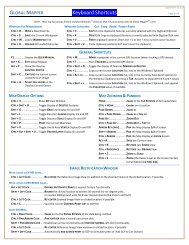Map GPS Coordinates - GPS Map Coordinates ... - Global Mapper
Map GPS Coordinates - GPS Map Coordinates ... - Global Mapper
Map GPS Coordinates - GPS Map Coordinates ... - Global Mapper
Create successful ePaper yourself
Turn your PDF publications into a flip-book with our unique Google optimized e-Paper software.
<strong>Global</strong> <strong>Map</strong>per User's Manual<br />
• Custom Palette from File - This option allows the user to choose a .pal file describing the palette to<br />
use for the export. A .pal file should be a text file with one line per color, with the red, green, and blue<br />
color components for each color in the palette separated by a comma. You can save a .pal file for an<br />
existing palette-based file by opening the Overlay Control Center, selecting the palette-based layer,<br />
press Options, then the Transparent Color button, then selecting the option to save a color palette file.<br />
• Grayscale - Min is Black Palette - This palette creates an 8-bit per pixel grayscale image with no<br />
color map stored in the image. Black will be stored as zero with varying shades of gray up to white<br />
with a value of 255.<br />
• Grayscale - Min is White Palette - This palette creates an 8-bit per pixel grayscale image with no<br />
color map stored in the image. White will be stored as zero with varying shades of gray up to black<br />
with a value of 255.<br />
The Vertical Units field allows the user to select the vertical units to use when exporting elevation data (i.e.<br />
meters or feet). Any input data not in the selected vertical units will be automatically converted on export.<br />
The Resolution section allows the user to selected the grid spacing to use when generating the GeoTIFF. The<br />
default value is the average of the grid spacings of all the currently loaded raster and elevation overlays. If the<br />
Always Generate Square Pixels option is checked, the smaller of the specified x and y resolutions will be used<br />
for both the x and y resolution. Forcing square pixels ensures that the resultant GeoTIFF file will look good<br />
even in software that is not able to deal with pixels that aren't square. If you'd like to specify the spacing in<br />
units other than those of the currently selected view/export projection, press the Click Here to Calculate<br />
Spacing in Other Units button.<br />
If you want to generate a GeoTIFF file corresponding to a particular scale relative to the selected DPI value<br />
(see below), you can check the Export at the Fixed Scale option and then specify the scale to use. For<br />
example, if you specify a scale value of 25000, each inch in the output (an inch being the number of pixels<br />
equal to the specified DPI value) will be approximately equivalent to 25,000 inches on the ground.<br />
The DPI Value to Save in Image option allows you to specify a DPI (dots per inch) value to save in the TIFF<br />
header. Some software, in particular graphics editing software, makes use of this value when sizing TIFF files<br />
for printout. Specifying the default value of 0 will result in the DPI tag not being saved to the TIFF file at all.<br />
The Compression selection allows you to select what type of compression to use for the selected export file<br />
type. The available compression types are as follows:<br />
• No Compression - The exported data is not compressed.<br />
• Packbits - The palette-based image will be compressed using the lossless Packbits algorithm.<br />
• LZW Compression - The data will be compressed using the lossless LZW algorithm. Note that not all<br />
applications can load a LZW-compressed GeoTIFF file.<br />
• CCITT/Fax4 - The 1-bit black-and-white image will be compressed using the lossless CCITT/Fax4<br />
algorithm.<br />
• JPEG Compression - The 24-bit color image will be compressed using the lossy JPEG algorithm.<br />
Note that not all applications support loading JPEG-in-TIFF encoded files.<br />
If the Make Background (Void) Pixels Transparent option is checked for 8-bit palette, 24-bit RGB, or<br />
JPEG-in-TIFF files, an alpha channel will be added to the created GeoTIFF file to indicate which pixels<br />
should be treated as transparent. Note that this will create a larger file and not all applications will support<br />
TIFF files with alpha channels.<br />
If the ADVANCED: Use Tile Rather than Strip Orientation option is checked, the GeoTIFF file will use a<br />
tile-based organization rather than a strip/scanline-based orientation. A tile-based orientation has advantages<br />
<strong>Map</strong> <strong>GPS</strong> <strong>Coordinates</strong> - <strong>GPS</strong> <strong>Map</strong> <strong>Coordinates</strong> - <strong>GPS</strong> <strong>Coordinates</strong> <strong>Map</strong> 34







